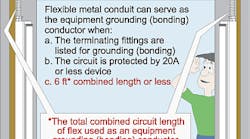All Code references are based on the 2005 NEC. The grounding and bonding requirements in this column apply to solidly grounded systems that operate at not more than 600V, such as 120/240V, 120/208V, and 277/480V.
Would you be surprised to learn that the equipment grounding conductor (EGC) doesn't connect anything directly to the earth (ground). Based on the definition of EGC in Art. 100, the EGC connects the non-current carrying metal parts of electrical systems to the system grounded conductor, the grounding electrode conductor, or both. Thus, the EGC isn't really a grounding conductor at all, but a bonding conductor.
According to Art. 100, bonding is the “permanent joining of metallic parts,” and grounding is a connection “to earth.” It's an important distinction: If you're joining metallic parts, you're bonding. If you're connecting to earth, you're grounding.
This isn't just a matter of semantics. Understanding this difference will help you avoid such mistakes as driving an “isolated ground” rod rather than running a bonding jumper to the system grounded conductor, the grounding electrode conductor, or both.
The EGC provides the low-impedance fault-current path that overcurrent protection devices need to operate. It's those devices that remove dangerous voltage potentials from between conductive parts of building components and electrical systems [250.2 and 250.4(A)(3)].
14 flavors. Art. 250 provides a list of 14 types of components you can use (singly or in combination) as an EGC (250.118). As you might expect, the first item on the list is a conductor. This can be wire or busbar made of copper, aluminum, or copper-clad aluminum. It can be bare or insulated.
The next three items are types of metallic nonflexible raceway: rigid metal conduit (RMC), intermediate metal conduit (IMC), and electrical metallic tubing (EMT). Chapter 3 in the NEC devotes an article to each of these: 342, 344, and 358, respectively. These raceways may outperform the conductors within them as bonding paths, especially at high frequencies.
Varieties of metallic flexible raceway occupy the next four spots: flexible metal conduit (FMC), liquidtight flexible metal conduit (LFMC), flexible metallic tubing (FMT), and Type AC armored cable.
Listed flexible metal conduit — FMC installations must meet four requirements [250.118(5)(a)-(d)]:
-
The conduit terminates in fittings listed for grounding.
-
The circuit conductors are protected by overcurrent devices rated 20A or less.
-
The combined length of the conduit in the same fault return path doesn't exceed 6 feet (Fig. 1).
-
The application requires flexibility.
Listed liquidtight flexible metal conduit — LFMC (Art. 350) installations must meet five requirements [250.118(6)(a)-(e)]:
-
The conduit terminates in fittings listed for grounding.
-
For trade sizes ⅜ inch through ½ inch, the circuit conductors are protected by overcurrent devices rated 20A or less.
-
For trade sizes ¾ inch through 1¼ inch, the circuit conductors are protected by overcurrent devices rated 60A or less.
-
The combined length of the conduit in the same ground return path doesn't exceed 6 feet.
-
The application requires flexibility.
Flexible metallic tubing — To qualify as an EGC, FMT (Art. 360) must terminate in fittings listed for grounding. The circuit conductors in the tubing must be rated at 20A or less, and the FMC must be no more than 6 feet long [250.118(7)(a)-(b)].
Type AC Cable — AC cable (Art. 320) is manufactured with an internal bonding strip that's in direct contact with the interlocked metal armor. The combination of the bonding strip and the interlocked metal armor makes the cable suitable as an effective ground-fault current path.
MI cable — The ninth item on the list is the copper metal sheath of mineral insulated (MI) cable (Art. 332). Take care with MI that you don't expose the sheath to corrosion.
Type MC cable — Where listed and identified for grounding, MC cable is a tenth option. But pay attention to whether it's interlocked, smooth, or corrugated tube type:
-
Interlocked Type MC must contain an EGC within the cable. The metal armor of interlocked Type MC isn't suitable as an effective ground-fault current path because — unlike Type AC — it doesn't have an internal bonding strip.
-
The sheath of smooth or corrugated tube Type MC is suitable as the effective ground-fault current path. Thus, you can use it as an EGC without a separate bonding conductor within the cable.
Metallic cable tray — You can use metallic cable tray as an EGC if continuous maintenance and supervision ensure that qualified persons service it [392.3(C)], and it meets two other requirements (392.7):
-
Cable tray and fittings are identified for grounding.
-
Cable tray, fittings, and raceways are bonded per 250.96 using bolted mechanical connectors or bonding jumpers sized per 250.102.
Cablebus framework — You can use this if it meets the requirements of 370.3.
Other electrically continuous metal raceways — Items like metal wireways are acceptable if they're listed for bonding.
Surface metal raceway — If it's listed for grounding, this is your fourteenth option.
Some ID, please. Individually covered or insulated EGCs must have a continuous outer finish that's green (or green with one or more yellow stripes). Conductors with green insulation (or green with one or more yellow stripes) can't be used for an ungrounded conductor or grounded neutral conductor (Fig. 2).
An insulated or covered EGC larger than 6 AWG may be permanently re-identified at the time of installation at every point where the EGC is accessible (250.119). But you don't have to identify EGCs larger than 6 AWG in conduit bodies.
EGC identification must encircle the EGC. You can choose from three ways to accomplish the identification:
-
Stripping exposed insulation from the entire exposed length.
-
Coloring the exposed insulation (or covering) green.
-
Marking exposed insulation with green tape or green adhesive labels.
Sizing the EGC. Size wire EGCs per Table 250.122 based on the ampere rating of the circuit-protection device. In no case does the EGC have to be larger than the circuit conductors.
The EGC must be capable of safely conducting any ground-fault current likely to be imposed on it (110.10 and Table 250.122). Otherwise, the EGC may burn clear before the protective device responds.
Suppose you increase ungrounded conductor size to accommodate voltage drop, excessive heating from harmonic currents, fault-current studies, or future capacity. What about the EGC size? Any time you increase the size of ungrounded circuit conductors — regardless of the reasons — you must proportionately increase the size of the EGC [250.122(B)]. The following problem illustrates this requirement.
Question: If you increase the size the ungrounded conductors for a 40A circuit from 8 AWG to 6 AWG, you would also need to increase the size of your EGC. If your EGC was 10 AWG, what size would it need to be now?
Answer: The circular mil area of 6 AWG is 59% greater than that of 8 AWG (26,240 cmil/16,510 cmil) (Chapter 9, Table 8).
The EGC for a 40A protection device can be 10 AWG (10,380 cmil) (Table 250.122), but you must increase it in size by a multiplier of 1.59.
EGC size = 10,380 cmil × 1.59 = 16,504 cmil
Therefore, the new EGC must be 8 AWG, per Chapter 9, Table 8.
When multiple circuits are installed in the same raceway or cable, you need only one EGC in the raceway. Size it per Table 250.122 based on the largest overcurrent device protecting the circuit conductors in the raceway.
When circuit conductors are run in parallel (310.4), you must install an EGC with each parallel conductor set (310.4). Size it based on the ampere rating of the circuit-protection device per Table 250.122 — unless ground-fault protection is installed for cables systems (Fig. 3).
If ground-fault protection is installed, size the EGC based on the ampere rating of the ground-fault protection per Table 250.122 where ground-fault protection of equipment is installed. The installation must meet the three following conditions, or you must size the EGC per the first method:
-
Maintenance and supervision ensure only qualified persons will service the installation.
-
Ground-fault protection is set to trip at not more than the ampacity of a single ungrounded conductor.
-
The ground-fault protection is listed for protecting an EGC.
Size EGCs for feeders based on the ampere rating of the circuit-protection device ahead of the feeder, per Table 250.122. In no case does the EGC need to be larger than the circuit conductors (Fig. 4).
Don't let the “grounding” part of the EGC confuse you. It's really the equipment bonding conductor. Don't think in terms of “grounding” equipment — that is, connecting it to the earth (Art.100). Think in terms of connecting it to the system grounded conductor, the grounding electrode conductor, or both). Remember, the low-impedance fault-current path you create is necessary for overcurrent protection devices to operate. Earth is not a low-impedance fault-current path.




